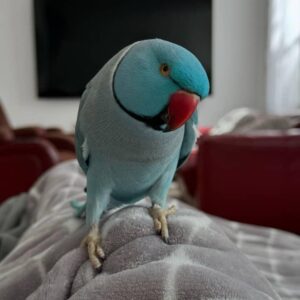Indian Ringneck Parrot
Indian Ringneck Parrot
Indian Ringneck Parakeets ( Psittacula krameri ) are vibrant and intelligent parrots native to India and Sri Lanka. They are popular as pets due to their relatively small size, striking plumage, and talking ability. Here’s a description of their key characteristics:
Physical Characteristics:
- Size: Medium-sized parrots, typically around 15-17 inches (38-43 cm) in length, including their long tail.
- Color: The most common color is green, but they also come in a variety of mutations, including blue, yellow, and white. Adult males develop a distinctive ring around their necks, hence their name. The ring can be black, pink, or a combination of both. Females and juveniles do not have the ring.
- Beak: Strong, curved beak used for cracking nuts, seeds, and manipulating objects.
- Lifespan: Indian Ringnecks can live for 20-30 years in captivity, sometimes even longer with proper care.
Personality and Intelligence:
Indian Ringnecks are intelligent, social, and playful birds with distinct personalities:
- Intelligent and Vocal: They are intelligent and possess excellent vocal abilities. Many are known for their ability to mimic human speech and other sounds, and some individuals develop extensive vocabularies. Their talking ability can vary individually, but they are generally considered good talkers.
- Social and Affectionate: They are generally social and enjoy interacting with their owners. They can be affectionate and form strong bonds, often preferring one person in the household. They need regular interaction to thrive.
- Playful and Energetic: They are playful and energetic birds that need plenty of exercise and mental stimulation. They enjoy playing with toys, exploring their surroundings, and interacting with their owners.
- Independent and Strong-Willed: They can be independent and strong-willed, requiring consistent training and socialization to prevent behavioral problems. Early and consistent training is key.
- Can be Noisy: While not as loud as some larger parrot species, they are capable of making a variety of vocalizations, including squawks, whistles, and chatter. They can be particularly noisy when they are excited or want attention.
- Sensitive: They are sensitive to their environment and the emotions of their owners. They can become stressed or depressed if neglected or treated harshly.
Important Considerations for Ownership:
- Commitment: Owning an Indian Ringneck is a significant long-term commitment due to their long lifespan.
- Socialization: Regular interaction with their owners is crucial for their emotional well-being. They need to feel like part of the family.
- Enrichment: They need a stimulating environment with plenty of toys, puzzles, and opportunities for foraging and exploration. A variety of enrichment is essential to prevent boredom and behavioral issues.
- Training: Consistent training is essential to manage their behavior and prevent unwanted habits. Positive reinforcement methods are most effective. Training is also important for developing their talking ability.
- Diet: A proper diet consisting of high-quality pellets, fresh fruits, vegetables, and occasional nuts and seeds is essential for their health.
- Veterinary Care: They require specialized avian veterinary care. Finding a vet experienced with Indian Ringnecks is important.
Indian Ringnecks can be wonderful companions, but their intelligence, long lifespan, and specific needs make them a challenging pet for some. Potential owners should thoroughly research their requirements and be prepared to make a significant commitment of time, money, and patience before bringing one home. Their talking ability is a major draw, but it’s important to remember that not all individuals will talk, and focusing on building a strong bond and providing proper care is more important than solely focusing on speech
Showing the single result

